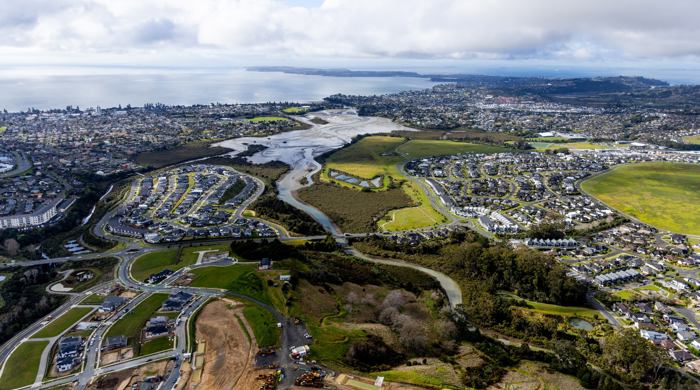Te whāomoomo i Aotearoa i tēnei rā
Conservation in Aotearoa / New Zealand today
Our biodiversity is in decline. We need to understand the drivers of loss to learn how to protect our environment for years to come.
Understanding the current drivers of biodiversity loss
Tāmaki Makaurau / Auckland has the lowest proportion of native land cover in the country, at just 25 per cent of what it once was.
Today, our region is home to 308 vascular plants, 54 birds, 18 terrestrial reptiles,11 freshwater fish species, two bats and one frog that are either 'threatened' or 'at risk of extinction' under the Department of Conservation's Threat Classification System. Many of these are only found in pest free sanctuaries or managed reserves, or on offshore islands.
So what are the main things driving the loss of biodiversity?
- Habitat loss largely due to urban development, industry and primary production has created fragmented ecosystems and isolated species populations.
- The Waitākere and Hūnua Ranges and foothills, and the islands of Aotea / Great Barrier, Hauturu-o-Toi / Little Barrier and Rangitoto, are the largest forested areas that remain in the region. They, along with other significant forests, wetlands, coastal ecosystems, islands and the marine environment (including three large harbours), provide a rich array of habitats that support thousands of native species. However, the fragmentation and isolation of these habitats can have negative impacts on indigenous species, even if these remnants are in good condition.
- Human habitation has led to secondary drivers such as pollution and the establishment of pest plants and animals. These factors continually degrade and modify the environment, reducing the ability of our terrestrial and marine ecosystems to support native species.
- Other significant drivers include direct predation and browsing by pest animals, which have threatened, displaced or caused the extinction of many species.
- Recreational and commercial fishing practices also put pressure on our fragile marine environment, affecting both marine and terrestrial ecosystems and species populations.
- The rapidly changing climate, primarily driven by human activities, poses challenges to the natural range of ecosystems and species through physical and chemical changes to the natural environment. Examples of this include rising sea levels, increased frequency of extreme weather events and higher average soil temperatures. Refer to the Intergovernmental Panel on Climate Change (IPCC) website for more information.
- A warmer climate also reduces the resilience of ecosystems and species and increases their exposure to invasive species and diseases not naturally found in Aotearoa. This is particularly critical in our increasingly subtropical climate where unwanted plants and animals can thrive, and native species struggle to compete, in warmer and more humid conditions.
Future human activities in our growing city must be carefully managed and monitored. These modern pressures and the historical impacts of human settlement all need to be considered together in order to understand and address the challenges to biodiversity protection in Auckland.

Why protect and restore our environment
Te taiao sets Aotearoa / New Zealand apart from the rest of the world. It gives our culture its uniqueness and special richness and nourishes our well-being.
We depend on the diversity and stability of the natural world for our long-term survival. If we ignore this, it will be at our peril. While indicators of biodiversity are often overlooked, it is these strands that we must monitor and protect so that we can preserve the fabric of the natural world as a whole.
In the 800 years that humans have occupied Aotearoa, we've lost over 70 per cent of our indigenous landcover and 75 species of plant and animal have become extinct.
The majority of extinctions have been birds, losing almost 50 per cent of known species since human occupation. Jared Diamond, American ecologist, described our decimated birdlife by stating that “New Zealand doesn’t so much as have an avifauna, but the wreckage of one.”
Our biodiversity is still in decline. Nationally, the total area of indigenous forest and scrub, dune ecosystems and wetlands continue to decline and around 3700 indigenous plant and animal species are threatened or at risk of extinction. With the largest urban population and the high value of land, it is no surprise that Tāmaki Makaurau / Auckland has the lowest proportion of indigenous landcover in the country at just 25 per cent.
In Tāmaki Makaurau / Auckland, 308 vascular plants, 49 birds, 16 terrestrial reptiles, 11 freshwater fish species, two bats and one frog are thought to be regionally threatened or at risk of extinction.
Despite these enormous historical losses and contemporary changes in Aotearoa / New Zealand, we still hold some of most unique and extraordinary biodiversity on earth. We have endemic species that can only be found here such as:
- kauri, tōtara and rimu
- wētāpunga
- tuatara
- kiwi, kakāpō and kokako.
These species, along with many others, depend on us for their survival and future preservation.
As we continue to separate ourselves from the environment, we need to acknowledge past mistakes and learn to live with te taiao (our environment). We need to treasure and preserve it, only taking what is essential to sustain life.






